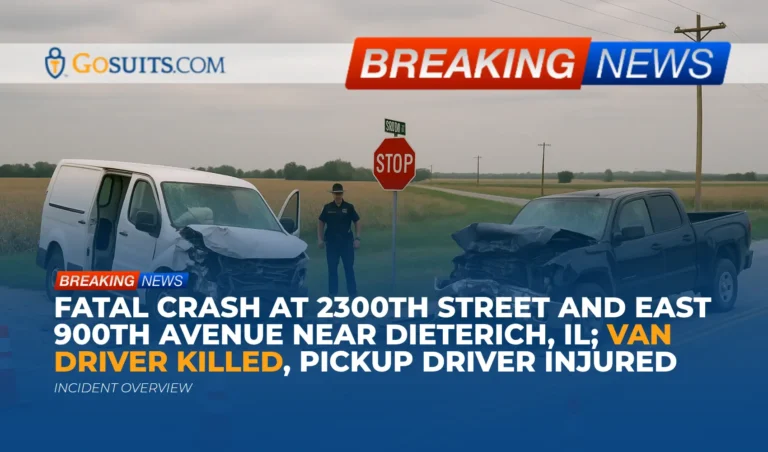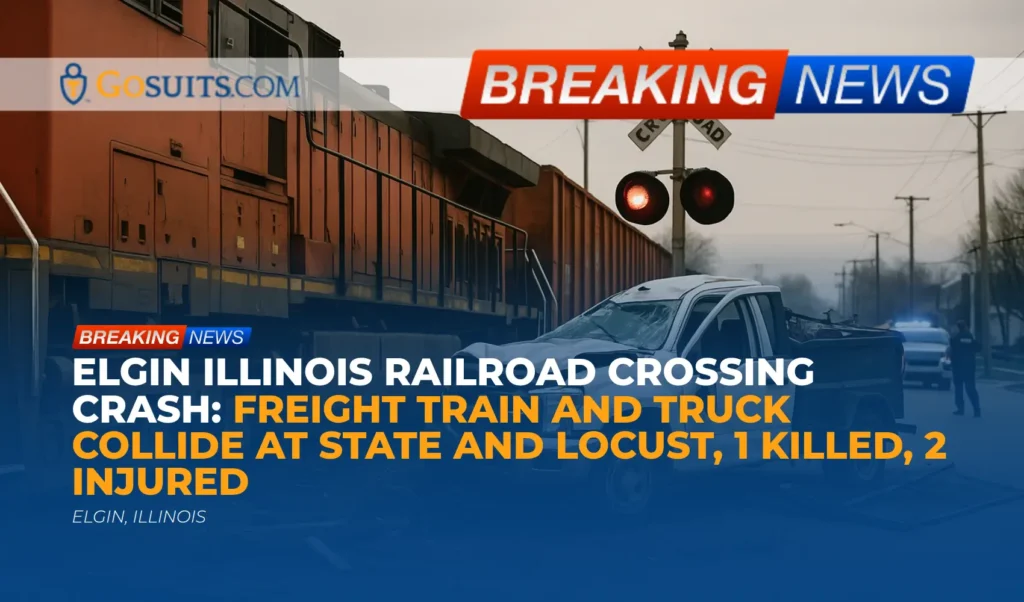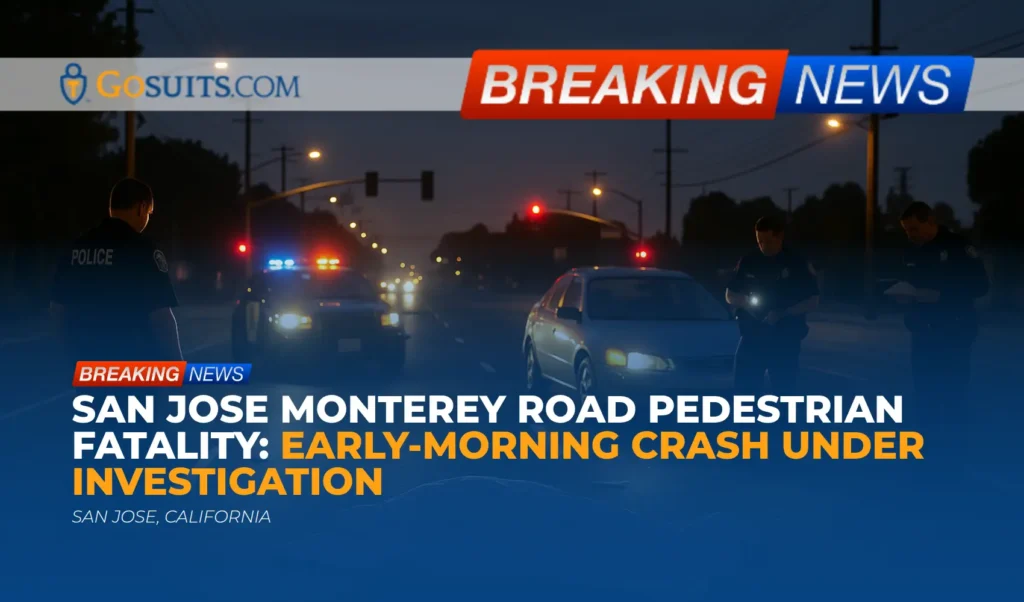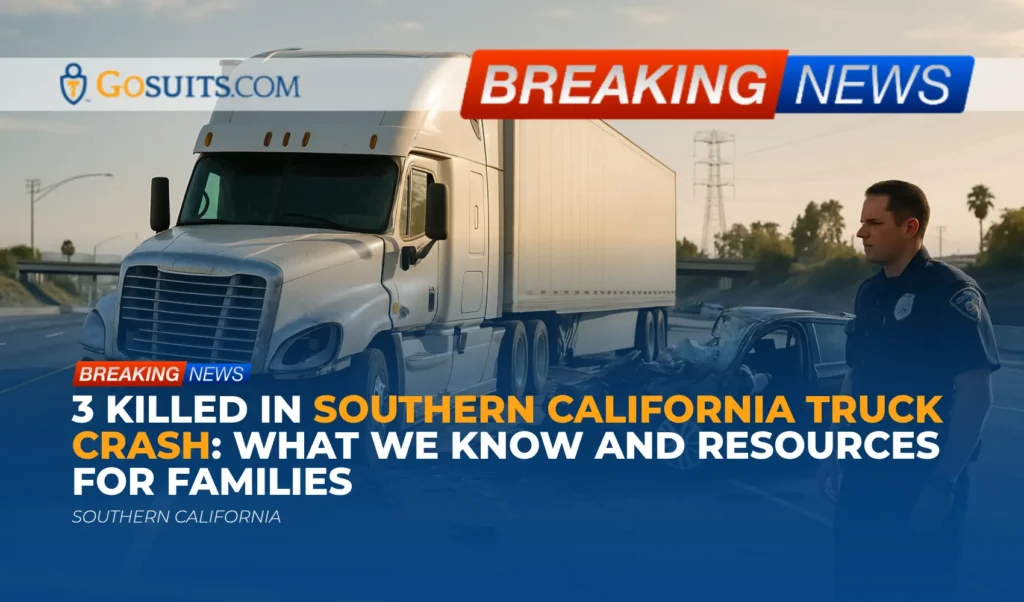- Incident overview
- What is known and what is not yet public
- How fatal crash investigations generally proceed in Illinois
- Where to obtain official records and who to call
- Legal rights after a fatal motor vehicle collision in Illinois
- Possible civil liability and insurance considerations
- Evidence to preserve as early as possible
- Steps to take before speaking with any insurance company
- Support and practical next steps for families
- Rural roadway safety context and why intersections can be high-risk
- Key timelines that can affect Illinois civil claims
- Commentary from Gosuits Dieterich, Illinois Personal Injury Attorney
- Why timely action matters now
- Sources
Incident overview
According to information released on October 19, 2025, one person was killed and another injured in a two-vehicle crash on Sunday morning near Dieterich in Effingham County, Illinois. The Illinois State Police responded around 8:30 a.m. to the intersection of 2300th Street and East 900th Avenue on the east edge of Dieterich. Authorities reported that the collision involved a pickup truck and a van. The driver of the van died from their injuries, and the driver of the pickup was transported for medical treatment. The roadway was closed during the investigation and reopened shortly after 12:30 p.m. Names of those involved have not yet been released by officials.
This article summarizes known facts and provides context to help community members understand typical investigative steps, the types of records that may be available, rights of those affected under Illinois civil law, and practical considerations about insurance and evidence. It is written in a compassionate, plain-language manner to support families dealing with sudden loss or injury.
What is known and what is not yet public
What is known:
- Location: 2300th Street and East 900th Avenue, near Dieterich, in Effingham County, Illinois.
- Time: Approximately 8:30 a.m. on Sunday, October 19, 2025.
- Vehicles: A pickup truck and a van.
- Injuries: The van’s driver died from injuries; the pickup driver was injured and transported for treatment.
- Response: Illinois State Police managed the scene, closed the roadway for investigation, and reopened it after about four hours.
What is not yet public:
- Identities: Names and ages of the involved drivers and any passengers have not been released.
- Cause: Officials have not published a determination of cause or contributing factors.
- Citations or findings: No public information yet about citations, fault assessments, or reconstruction outcomes.
When authorities complete key steps such as scene documentation, vehicle inspections, and report drafting, additional details may be available in official records. Families often must request those records directly from the relevant public agencies.
How fatal crash investigations generally proceed in Illinois
In Illinois, a fatal traffic collision typically involves coordinated work by law enforcement and the county coroner, with steps that may include:
- Scene safety and medical response: First responders secure the area, provide medical aid, and coordinate with emergency medical services.
- Scene documentation: Investigators photograph and measure the scene, document vehicle rest positions, identify skid or yaw marks, note roadway controls, and record environmental factors such as lighting and weather.
- Witness interviews: Officers take statements from involved drivers, passengers, and independent witnesses, when available.
- Vehicle inspections: Vehicles may be examined for mechanical issues, safety system performance, and crash damage patterns. In some cases, event data recorder information can be downloaded.
- Coroner’s investigation: The county coroner determines cause and manner of death. This may involve autopsy, toxicology, and collection of identifying and medical information.
- Report preparation: A formal traffic crash report is drafted, and in serious or fatal incidents, supplemental reconstruction reports may be prepared.
For incidents in the Effingham County region, the Illinois State Police District 12 often leads or participates in investigations on state and rural roadways. Public-facing information about District 12 is available through the Illinois State Police website. Families can later request the crash report and, where appropriate, supplemental materials from the agency through the Illinois State Police’s public records process.
Where to obtain official records and who to call
In the aftermath of a fatal crash, certain official records can help families understand what happened and support civil processes such as insurance claims and probate. Availability and timing vary, and some records may be restricted while investigations are active. Below are common points of contact and the types of records they hold.
Illinois State Police crash report and related records
- Crash report: The primary traffic crash report contains the basic facts, diagram, and narrative. In serious or fatal cases, there may also be reconstruction or supplemental reports.
- How to request: Requests for Illinois State Police records are generally made under the Illinois Freedom of Information Act. Guidance is available at the Illinois State Police FOIA page. When requesting, include the date, time, location, and any incident number if known.
- Where to learn more: See the Illinois State Police District 12 page for district contact information and the statewide FOIA portal for instructions.
Helpful links:
- Illinois State Police District 12
- Illinois State Police FOIA Requests
- Illinois Freedom of Information Act, 5 ILCS 140
Effingham County Coroner and autopsy-related records
- What is available: The county coroner determines cause and manner of death and may authorize an autopsy and toxicology testing. Families can typically request certain coroner records after completion, subject to legal restrictions.
- How to request: Contact the Effingham County Coroner’s Office through the official county government channels to ask about availability, process, and any fees. Processing times can vary depending on lab results and caseload.
If you are unsure where to start, the main county government website or main administrative offices can direct you to the coroner’s office and its records procedures.
Death certificates
- What is available: Certified copies of death certificates are issued through the Illinois Department of Public Health and county clerks. These are typically needed for estate, insurance, and benefits matters.
- How to request: IDPH provides guidance on eligibility, required identification, and ordering methods for death records.
- Where to learn more: IDPH’s death records page outlines statewide procedures and links to local offices.
Helpful link:
Crash data and roadway context
- IDOT crash data: The Illinois Department of Transportation maintains statewide crash data that can illuminate trends and roadway characteristics. While not a substitute for the specific police report, these datasets provide useful context.
Helpful link:
Legal rights after a fatal motor vehicle collision in Illinois
When a fatal collision occurs, Illinois civil law provides avenues for surviving family members and the decedent’s estate to seek accountability through the courts. The specific facts of any incident guide the analysis, but the following frameworks commonly apply:
- Wrongful death claims: Illinois’ Wrongful Death Act allows the personal representative of the decedent to pursue damages for the exclusive benefit of the surviving spouse and next of kin. Recoverable categories can include loss of society, grief, and financial support, subject to proof and the court’s instructions. See the Wrongful Death Act for statutory language.
- Survival claims: A separate claim may proceed under the Survival Act to recover damages the decedent could have sought if they had lived, such as conscious pain and suffering and certain medical expenses incurred before death.
- Personal injury claims for survivors: Individuals injured in the same crash can bring their own personal injury claims to recover for medical expenses, lost income, and non-economic harms recognized by Illinois law.
Helpful links:
Nothing here is a substitute for a case-specific consultation. Facts such as roadway controls, vehicle movements, speeds, visibility, and witness accounts can alter the legal analysis.

Possible civil liability and insurance considerations
Investigations of rural intersection crashes often focus on whether any driver breached a duty of ordinary care. Without speculating about the cause of this specific collision, the following Illinois Vehicle Code provisions commonly arise in intersection cases:
- Obedience to stop and yield signs: Drivers must stop as required and yield the right-of-way where appropriate. See 625 ILCS 5/11-904.
- Speed restrictions: Drivers must operate at a speed that is reasonable and prudent under the conditions, including the duty to reduce speed to avoid collisions. See 625 ILCS 5/11-601.
Liability in civil cases is determined under Illinois negligence principles. One or more parties can share responsibility. Illinois follows a modified comparative negligence rule. A claimant who is more than 50 percent at fault is barred from recovery; otherwise, damages may be reduced in proportion to fault.
Helpful link:
Insurance considerations in Illinois:
- Liability coverage: Illinois requires minimum motor vehicle liability insurance limits by statute. While minimums may apply, different policies can carry higher limits, and multiple coverages may be implicated in serious injury and wrongful death matters.
- Uninsured and underinsured motorist coverage: Depending on the policies involved, UM/UIM coverage can provide an additional layer of protection when an at-fault party lacks adequate insurance.
- Commercial versus personal policies: If a vehicle was being used for work or owned by a business, commercial coverage may apply, which can change investigation and claims strategies.
Helpful link:
Evidence to preserve as early as possible
Preserving evidence soon after a collision can make a significant difference in understanding what happened. Even before all reports are released, it is practical to identify and secure the following:
- Vehicles and onboard data: Modern vehicles may store crash-related data in an event data recorder, including speed, braking, throttle, seatbelt status, and airbag deployment. Preservation and proper download typically require prompt action to avoid loss due to repairs, disposal, or power interruptions.
- Scene evidence: Tire marks, gouges, debris fields, and damage to roadside features can be fleeting. Photographs, measurements, and drone imagery captured early can aid reconstruction.
- Witness information: Names, contact information, and statements from independent witnesses are valuable and can be difficult to locate later.
- 911 audio and dispatch logs: These records may contain timing, location, and initial observations. Agencies can have retention limits, so timely requests are important.
- Nearby cameras: Private security cameras, doorbells, agricultural facility cameras, and traffic cameras may capture approach paths or the collision. Many systems overwrite within days.
- Medical documentation: Emergency medical records, hospital records, and transport logs help document injuries and treatments.
- Cell phone records: In appropriate cases, phone usage data can shed light on potential distraction. Access typically requires formal legal process.
Helpful links:
Spoliation letters and preservation notices are commonly used to formally ask individuals, businesses, and insurers to retain evidence. Early legal guidance can help ensure requests are properly directed and documented.
Steps to take before speaking with any insurance company
Insurance adjusters often reach out quickly after a serious crash. Recorded statements or informal conversations can be used later in ways that are not always obvious at the start. Before any contact with insurers:
- Consult a qualified attorney first: A free consultation can help clarify rights, responsibilities, and risks. What is said early to an insurer can be used against the claimant or the estate later.
- Do not guess or speculate: If you choose to speak, avoid guessing about speeds, distances, or causation.
- Limit releases: Broad medical authorizations and blanket record releases can expose private information not relevant to the claim.
- Request written communications: Keeping a written record reduces confusion and preserves clarity about what was said.
- Identify all potential coverages: Liability, UM/UIM, med pay, and umbrella policies may be implicated. An attorney can help locate and interpret policies.
Support and practical next steps for families
After a sudden loss or serious injury, practical needs often arise alongside grief. While every family’s situation is different, the following steps can help with organization and essential tasks:
- Designate a point of contact: Choose a trusted person to coordinate communications with investigators, medical providers, and, if applicable, the coroner’s office.
- Collect key documents: Secure identification, insurance cards, vehicle registration, any existing estate planning documents, and contact information for potential witnesses.
- Track expenses: Keep receipts and records of medical bills, funeral or memorial expenses, travel, and time missed from work by family caregivers. Documentation supports insurance and civil claim processes.
- Request official records: Begin with the Illinois State Police crash report process and the county coroner’s office for status updates. Ask about timelines for report release.
- Consider probate steps: In wrongful death and survival actions, a personal representative is typically appointed through the county’s probate court to act on behalf of the estate.
- Seek emotional support: Grief resources and counseling through local health departments, faith communities, or licensed providers can help families navigate the weeks and months ahead.
Rural roadway safety context and why intersections can be high-risk
Rural intersections can present unique hazards: limited sight lines due to crops or terrain, higher typical travel speeds, and fewer traffic control devices than urban areas. National highway safety authorities have documented elevated risks on rural roads.
- Rural road risk: National data show rural roads experience a disproportionate share of fatal crashes relative to vehicle miles traveled, reflecting factors like speed, roadway geometry, and longer emergency response times.
- Intersection safety: Safety countermeasures for rural intersections include improved signing and markings, rumble strips, better sight distance, enhanced lighting, and consideration of geometric improvements where warranted.
Helpful links:
While generalized data cannot explain any individual crash, these resources help communities understand common contributing factors and potential engineering countermeasures that agencies consider to improve safety over time.
Key timelines that can affect Illinois civil claims
Illinois law includes deadlines that can affect civil claims after a fatal or serious crash. Because these timelines can be complex and fact-dependent, the points below are general. For specific guidance, consider a case review with an attorney.
- Personal injury statute of limitations: Two years for actions for damages for injury to the person, measured from the date of injury in most cases. See 735 ILCS 5/13-202.
- Wrongful death timing: The Wrongful Death Act has its own timing provisions that generally require actions to be commenced within two years of death, subject to statutory exceptions.
- Governmental entities: If a public entity is a potential defendant, additional immunities and timing provisions can apply under Illinois law, which may shorten deadlines or impose specific notice requirements.
- Probate steps: Appointment of a personal representative may be required to pursue wrongful death and survival actions. Opening an estate is typically done in the county where the decedent resided at death.
- Record retention: Agencies and private entities have limits on how long they keep certain records such as 911 audio and camera footage. Early preservation requests are important.
Helpful links:
Commentary from Gosuits Dieterich, Illinois Personal Injury Attorney
Our hearts are with everyone affected by the collision near 2300th Street and East 900th Avenue. Sudden loss and injury change lives in an instant, and the early days are often confusing and painful. This commentary is offered for general information and educational purposes, grounded in respect for those who are hurting.
Based on what is publicly known, this was a serious rural intersection crash with tragic consequences. At this stage, authorities have not released names or a cause. In our experience with rural roadway cases, careful attention to roadway controls, sight lines, approach speeds, and vehicle movements is essential. Independent documentation, including photographs, mapping of the scene, and preservation of vehicle data, can be as important as the official crash report when establishing a clear picture of what happened.
Insurance companies and large corporate risk departments often move quickly to protect their interests. Adjusters may ask for recorded statements or broad medical releases before families understand the full scope of injuries, losses, or the law. It is common for early outreach to feel supportive while also gathering information that can later be used to minimize or deny valid claims. Knowing the difference between routine information and prejudicial statements is not easy without guidance.
A free consultation with a seasoned injury attorney can offer clarity about rights, timelines, preservation of evidence, and potential coverage layers such as underinsured motorist protection. It can also help families avoid missteps with insurers while they are still waiting on critical documents like the crash report and coroner’s findings. No one should have to navigate these issues alone while grieving or recovering.

Why timely action matters now
Time matters after a serious or fatal crash, not for legal posturing, but to protect facts, records, and options that are easily lost. Taking organized steps early can make a real difference in how the facts are understood and how families are treated by insurers.
- Secure official records promptly: Initiate requests for the Illinois State Police crash report and coroner records. Agencies can have backlogs, and some materials are released in stages.
- Preserve vehicles and data: Ask custodians not to alter or dispose of vehicles, and request preservation of event data recorder information. Early preservation helps avoid permanent loss.
- Identify all insurance coverages: Map out possible policies, including liability, UM/UIM, med pay, and any applicable commercial or umbrella coverage. Overlooking a policy can leave benefits unrealized.
- Control communications: Route insurance communications through a designated representative and consider obtaining legal guidance before any recorded statements. Statements given too soon can be misunderstood or incomplete.
- Track expenses and impacts: Maintain a file for medical bills, funeral costs, travel, caregiving time, and other out-of-pocket expenses. Accurate records support claims and reduce disputes later.
- Watch the calendar: Statutes of limitations, agency retention schedules for 911 audio or video, and probate milestones all carry deadlines. Early planning prevents avoidable time pressure.
- Seek supportive services: Access grief counseling or community support resources to help with the human side of loss and recovery. Emotional support strengthens decision-making during a difficult time.
Sources
The following government resources offer authoritative background on topics discussed above. They provide general information and do not address the specific facts of this incident.
- Illinois State Police District 12
- Illinois State Police FOIA Requests
- Illinois Freedom of Information Act, 5 ILCS 140
- Illinois Department of Public Health Death Records
- Illinois Department of Transportation Crash Data
- Illinois Vehicle Code, 625 ILCS 5/11-904, stop and yield
- Illinois Vehicle Code, 625 ILCS 5/11-601, speed restrictions
- 735 ILCS 5/2-1116, comparative negligence
- 740 ILCS 180, Wrongful Death Act
- 755 ILCS 5/27-6, Survival actions
- 735 ILCS 5/13-202, two-year limitation for personal injury
- 625 ILCS 5/7-203, minimum liability insurance requirements
- NHTSA Rural Road Safety
- FHWA Rural Intersection Safety
- NHTSA Event Data Recorder overview






